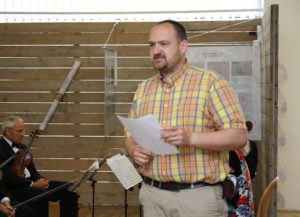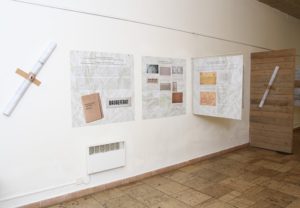
Historian of the Terezin Memorial Tomáš Fedorovič during the opening of the exhibition, July 2016, photo: Radim Nytl, Památník Terezín.
On July 14, 2016 guests gathered in the lobby of the cinema of the Ghetto Museum in Terezín to attend a preview of a documentary exhibition staged by the Terezín Memorial and called Testimony of the Town’s Changes – Terezín in the Building Plans and Documents of the Jewish Self-Administration 1941-1945.
This exhibition seeks to offer a comprehensive insight into the planned changes of the Terezín Ghetto, some of which had been partly realized, while others remained only on paper.
The art design of the display is the work of Miroslav Veselý, graphic designer of the Terezín Memorial, who has succeeded – in a truly original fashion – to incorporate period archive documents, processed by the Terezín Memorial’s historian, Mgr. Tomáš Fedorovič, into an unusual mosaic that is highly likely to be very impressive for the visitors.
The author of the script for the exhibition, Tomáš Fedorovič, summarized his work and preparations for the exhibition in the following comments.
1. Why have you chosen the theme of Terezín and its changes in the building plans and documents of the Jewish Self-administration in the first place?
Perhaps, to put it into a nutshell, I do not like doing things somebody else has already done before me. To tell the truth, I have known of the file of documents of the Technical Office, stored in the State District Archives Litoměřice in Lovosice, for more than fifteen years, i.e. roughly since the time I joined the Terezín Memorial. But my determination to use these materials for exhibition purposes “matured” this long. Nevertheless, of great importance for me was the unique value of these rare documents, maps and drawings. It is really fascinating to learn how much dedication and efforts, what a great amount of talent and skills the employees of the Technical Office had to expend in an effort to improve – or at least to prevent from deteriorating – the prison conditions for the Terezín inmate. In fact, “not a brick was moved” in the Ghetto without their blueprints and technical drawings. It is a completely different thing that their work was, on the one hand, actually helping the SS office agency in Terezín and, on the other hand, was brutally abused by the SS. Last but not least, I am keen on tracing the development of the Ghetto, as outlined in his Terezín report by Otto Zucker, by going through the background materials prepared on the drawing boards.
2. Could you describe the content of your archive research and specify how much time you had to spend in preparations for this exhibition?
In actual fact, the entire package of building blueprints and documents made in the Technical Office was to serve as kindling paper but thanks to many coincidences the file escaped unscathed. Its documents are sorted out according to individual house blocks. Strangely enough, all the documentation concerning the Terezín barracks is missing. These are, on the contrary, to be found in the Jewish Museum in Prague. A significant section of this collection consists of plans of objects lying on the periphery of the Ghetto, i.e. the central mortuary, columbarium, or even beyond its borders, which applies to the central washhouse or the crematorium.
Preparations for the exhibition took about six months, I went through the entire file twice; during my first inspection I took notes on the individual documents we wanted to present, on the second occasion, working with my colleague Radim Nytl from the Department of Documentation, we took exhibition-quality photographs of those selected documents.
3. Was there something, during your research, that surprised you? What would you like to single out yourself?
I tried to select the most interesting documents for an exhibition divided into 23 thematic areas, and all the documents are actually unique. I would like to mention three areas, which are, in my opinion, worth seeing in particular. The first one is the phenomenon of Terezín attics that had a much greater role to play in the life of Terezín inmates than we have thought so far. We have tried to cram the subjects of their inhabitants, their equipment, persons who gave permission for the construction of such privileged housing since the fall of 1943, into two exhibition panels. The other surprising aspect for me, as a historian studying the former Terezín Ghetto, was the finding that the Jewish Elder (Judenältester) ”did not work in office“ only in the Magdeburg Barracks, as we read in the literature portraying the Ghetto’s history, but also on the first floor of the building of today’s Terezín Post-office (Q 617). And last but not least, definitely worth seeing are the unrealized plans drawn up by the Terezín Administration, projects that bore a purely Germanizing hallmark. These are drawings of the adjustment of the hereditary farm of Erich Oswald Ludwig in Remstädt near Gotha. Paradoxically, there is no mention of these events either in the domestic archives or in foreign sources, and we are, therefore, left to wonder how and why did the Terezín Self-administration or rather the SS office agency in the Ghetto happen to have anything in common with such projects. No less important document is the plan of a grandiosely conceived sporting and cultural center prepared in June 1942. We know from Mahler´s diary that its mock-up was even made according to that plan in November 1942. The time sequence of events could suggest that the plans and the model should have been presented to Himmler during his planned, but unrealized visit to the Terezín Ghetto in December 1942.
4. Can you tell us on which subject you are currently working? What will be the topic of your next exhibition?
At present we are just about finishing the script for an eventual permanent exhibition called Terezín Transports. Deportation of Jews to Terezín and from the Terezín Ghetto to Places of Extermination and Slave Labor. In 2018 we plan to open an exhibition on health care in wartime Terezín.
The exhibition Testimony of the Town’s Changes – Terezín in the Building Plans and Documents of the Jewish Self-Administration 1941-1945 is held to mark the 75th anniversary of the establishment of the Terezín Ghetto and the start of deportations of Jews from the Czech lands, commemorated by the Terezín Memorial this year. The exhibition may be viewed until October 31, 2016.
Šv



